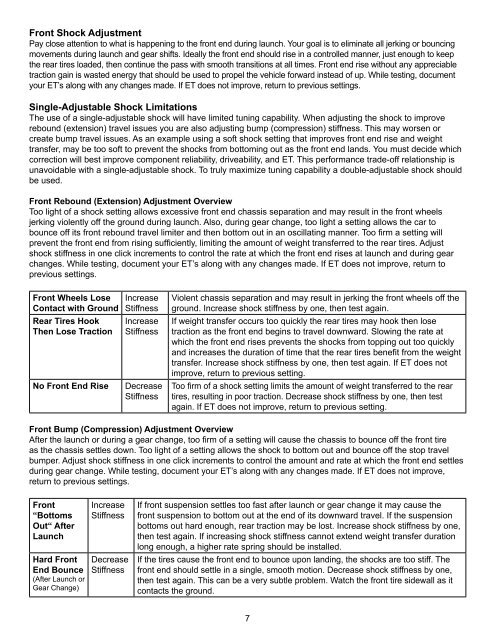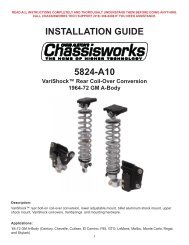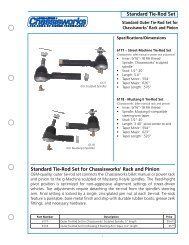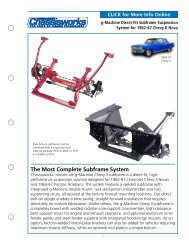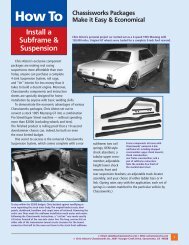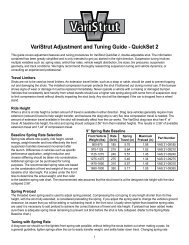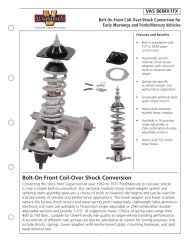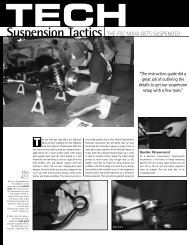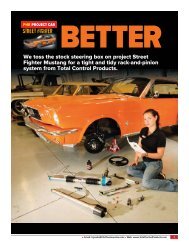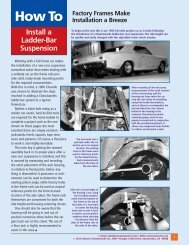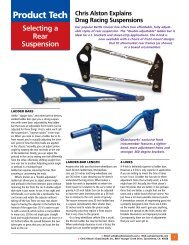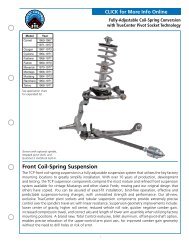Installation Instructions - Chris Alston's Chassisworks
Installation Instructions - Chris Alston's Chassisworks
Installation Instructions - Chris Alston's Chassisworks
Create successful ePaper yourself
Turn your PDF publications into a flip-book with our unique Google optimized e-Paper software.
Front Shock AdjustmentPay close attention to what is happening to the front end during launch. Your goal is to eliminate all jerking or bouncingmovements during launch and gear shifts. Ideally the front end should rise in a controlled manner, just enough to keepthe rear tires loaded, then continue the pass with smooth transitions at all times. Front end rise without any appreciabletraction gain is wasted energy that should be used to propel the vehicle forward instead of up. While testing, documentyour ET’s along with any changes made. If ET does not improve, return to previous settings.Single-Adjustable Shock LimitationsThe use of a single-adjustable shock will have limited tuning capability. When adjusting the shock to improverebound (extension) travel issues you are also adjusting bump (compression) stiffness. This may worsen orcreate bump travel issues. As an example using a soft shock setting that improves front end rise and weighttransfer, may be too soft to prevent the shocks from bottoming out as the front end lands. You must decide whichcorrection will best improve component reliability, driveability, and ET. This performance trade-off relationship isunavoidable with a single-adjustable shock. To truly maximize tuning capability a double-adjustable shock shouldbe used.Front Rebound (Extension) Adjustment OverviewToo light of a shock setting allows excessive front end chassis separation and may result in the front wheelsjerking violently off the ground during launch. Also, during gear change, too light a setting allows the car tobounce off its front rebound travel limiter and then bottom out in an oscillating manner. Too firm a setting willprevent the front end from rising sufficiently, limiting the amount of weight transferred to the rear tires. Adjustshock stiffness in one click increments to control the rate at which the front end rises at launch and during gearchanges. While testing, document your ET’s along with any changes made. If ET does not improve, return toprevious settings.Front Wheels LoseContact with GroundRear Tires HookThen Lose TractionNo Front End RiseIncreaseStiffnessIncreaseStiffnessDecreaseStiffnessViolent chassis separation and may result in jerking the front wheels off theground. Increase shock stiffness by one, then test again.If weight transfer occurs too quickly the rear tires may hook then losetraction as the front end begins to travel downward. Slowing the rate atwhich the front end rises prevents the shocks from topping out too quicklyand increases the duration of time that the rear tires benefit from the weighttransfer. Increase shock stiffness by one, then test again. If ET does notimprove, return to previous setting.Too firm of a shock setting limits the amount of weight transferred to the reartires, resulting in poor traction. Decrease shock stiffness by one, then testagain. If ET does not improve, return to previous setting.Front Bump (Compression) Adjustment OverviewAfter the launch or during a gear change, too firm of a setting will cause the chassis to bounce off the front tireas the chassis settles down. Too light of a setting allows the shock to bottom out and bounce off the stop travelbumper. Adjust shock stiffness in one click increments to control the amount and rate at which the front end settlesduring gear change. While testing, document your ET’s along with any changes made. If ET does not improve,return to previous settings.Front“BottomsOut“ AfterLaunchHard FrontEnd Bounce(After Launch orGear Change)IncreaseStiffnessDecreaseStiffnessIf front suspension settles too fast after launch or gear change it may cause thefront suspension to bottom out at the end of its downward travel. If the suspensionbottoms out hard enough, rear traction may be lost. Increase shock stiffness by one,then test again. If increasing shock stiffness cannot extend weight transfer durationlong enough, a higher rate spring should be installed.If the tires cause the front end to bounce upon landing, the shocks are too stiff. Thefront end should settle in a single, smooth motion. Decrease shock stiffness by one,then test again. This can be a very subtle problem. Watch the front tire sidewall as itcontacts the ground.


